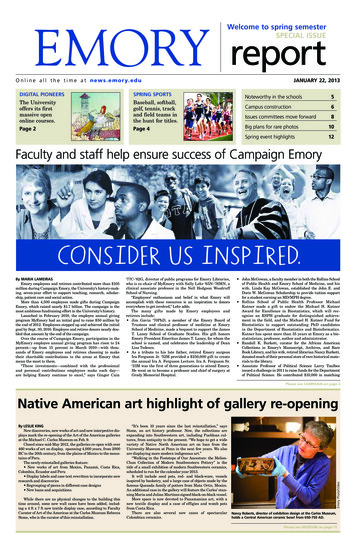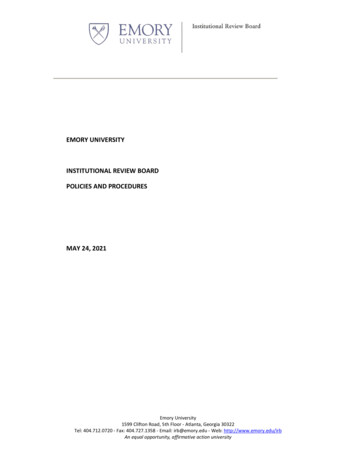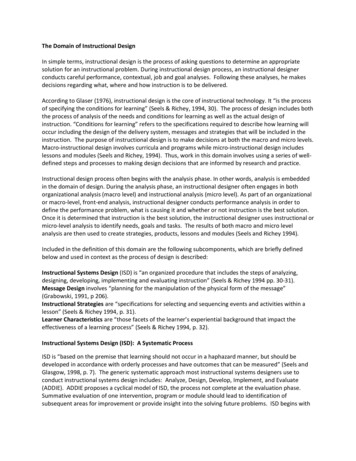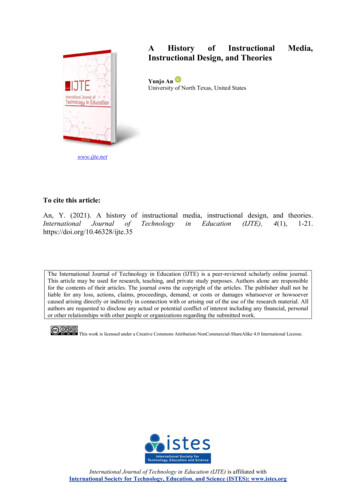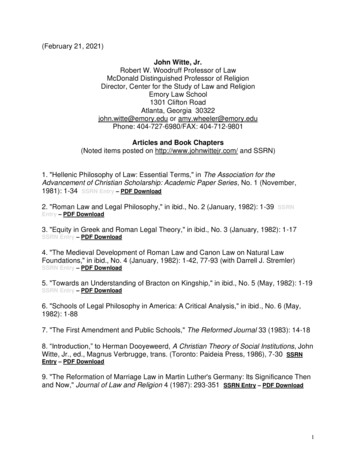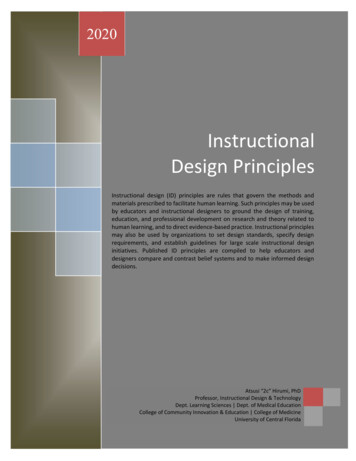
Transcription
2020kshopInstructionalDesign PrinciplesInstructional design (ID) principles are rules that govern the methods andmaterials prescribed to facilitate human learning. Such principles may be usedby educators and instructional designers to ground the design of training,education, and professional development on research and theory related tohuman learning, and to direct evidence-based practice. Instructional principlesmay also be used by organizations to set design standards, specify designrequirements, and establish guidelines for large scale instructional designinitiatives. Published ID principles are compiled to help educators anddesigners compare and contrast belief systems and to make informed designdecisions.Atsusi “2c” Hirumi, PhDProfessor, Instructional Design & TechnologyDept. Learning Sciences Dept. of Medical EducationCollege of Community Innovation & Education College of MedicineUniversity of Central FloridasCopyright 2020 Atsusi “2c” Hirumi, PhD1
Table of ContentsBehavioral Design Principles3Cognitive Information Processing Design Principles4Multimedia Design Principles5Evidenced-based Micro [Learning] Strategies7Cognitive Constructivist Design PrinciplesUniversal Principles of Experiential Learning10Adult Learning Principles11Learner-Centered Psychological Principles12Cognitive Constructivist Teaching Practices and Principles14Social Constructivist Teaching Practices and Principles15Neurobiological Design PrinciplesBrain-Based (Natural) Learning Principles16Principles of Brain-Based Learning17Brain Rules19Multi-Disciplinary Design PrinciplesFirst Principles of Instruction20Science of Learning: How People Learn21Make it Stick: The Science of Successful Learning22Applying the Science of Learning to the University and Beyond24Science of Learning: Dean’s for Impact26Learning About Learning: What Every New Teacher Needs to Know28References30sCopyright 2020 Atsusi “2c” Hirumi, PhD2
Behavioral Design Principles(Reeves & Reeves, 2015)In the early to mid-1900’s, scientists recognized that learning occurred inside the brain, but since theycould neither see nor measure such internal processes, they relied on observations of overt behaviors toexplain and predict human learning. Behaviorists’ viewed learning as a change in behavior that could beexplained by external factors and behavioral conditioning. Interest in behaviorism peaked between 1955to 1965 with the development of analog teaching machines and programmed instruction (Lumsdaine &Glaser, 1960, as cited in Reeves & Reeves, 2015). Behaviorists argued that operant conditioning and otherprinciples related to reinforcement could be used to teach students in varied educational settings (Reiser2001).Instructional design principles derived from behaviorist learning theory include: Active learner participation in responding to instructional stimuli is much more effective than passiveobservation of instruction. Behaviors that are rewarded are more likely to be repeated than behaviors that are ignored. Immediate reinforcement is more effective in most cases than delayed reinforcement. Intermittent reinforcement is more effective than constant reinforcement. – Extinction, i.e.,withholding reinforcement of a behavior or ignoring it can result in the decrease of that behavior. fulmethodfordeveloping fine motor skills such asplaying a piano or injecting a vaccine. Information should be presented in small amounts so that responses to questions about theinformation can be reinforced frequently.(Reeves & Reeves, 2015, p. 468-469)sCopyright 2020 Atsusi “2c” Hirumi, PhD3
Cognitive Information Processing Design Principle(Reeves & Reeves, 2015)By the mid to late 1900’s, psychologists reasoned that we could no longer ignore what was happening inbrain to explain complex forms of learning, and began to formulate cognitive theories of human learning.In addition to observations, cognitive theories explain learning based on paper and pencil tests thatmeasure internal psychological constructs, such as intrinsic and extrinsic motivation (Schunk, Meece, &Pintrich, 2013), Cognitive information processing (CIP) theories relate human learning to functions ofcomputers in which different types of memory, such short-term, long-term and working memory(Anderson, 2000). CIP theories are especially popular among cognitive and computer scientists involved indeveloping intelligent tutoring systems and other applications of artificial intelligence to promote learning(VanLehn, 2011, as cited in Reeves & Reeves, 2015).Instructional design principles derived from cognitive information processing learning theory include: Working (short-term) memory has inherent limitations that place a cognitive load on learningprocesses that must be carefully managed during instruction. Instruction should be designed tominimize the cognitive load of extraneous factors (e.g., the user interface of a computer program) andmaximize the cognitive capacity to process information needed for learning. There are two separate channels that humans use for processing information during instruction, theauditory and visual, and thus, instruction should provide verbal and graphical information in ways thatclearly guide the learners to identify and process relevant words and images. Learning occurs when humans identify, filter, select, link, organize, and integrate information underthe guidance of a tutor, which may be human or computer-based. Content to be learned should be organized from simple to complex.(Reeves & Reeves, 2015, p. 469-470)sCopyright 2020 Atsusi “2c” Hirumi, PhD4
Cognitive Theory of Multimedia Learning and 12 Principles of Multimedia Design(Mayer, 2009)Based on numerous experiments and Paivio's dual-coding theory, Baddeley's model of working memory,Wittrock's theory of generative learning, and Sweller's cognitive load theory, Mayer (2009) derived threebasic assumptions about how humans process information. The summary of the three assumptions arequoted directly from rning/.The Dual-Channel AssumptionAccording to Mayer (2009), the dual-channel assumption dictates that “humans possess separate channelsfor processing visual and auditory information” (p. 63). The first is the visual–pictorial channel, whichprocesses images seen through the eyes (including words displayed on a screen). The other channel is theauditory–verbal channel, which processes spoken words.The Limited-Capacity AssumptionThe limited-capacity assumption suggests that humans have a hard limit on the amount of informationthey can process at any given moment. This is probably intuitive to anyone who’s sat in a sports bar andtried to watch several games at the same time or tried to listen to the news while having a conversation.Although it’s difficult to nail it down, Mayer suggests that most people can maintain maybe five to seven“chunks” of information in working memory at a given time (p. 67). He also indicates that individuals at thehigher end of that range may have stronger metacognitive strategies, which allow them to manage theirlimited cognitive resources more efficiently.The Active-Processing AssumptionThe active-processing assumption asserts that humans don’t learn by just passively absorbing information.Instead, they need to engage in active cognitive processes, namely identifying and selecting relevantmaterial, organizing it into visual and/or verbal models, and integrating those new models with priorknowledge (p. 70). The cognitive theory of multimedia learning fundamentally argues against a“knowledge transmission” approach to learning in favor of a student-centered “knowledge construction”model. Students, he argues, are not “empty vessels” waiting to be filled up with information but mustinstead work to synthesize words and pictures into meaningful information that is stored in long-termmemory.The three assumptions serve as the foundation of Mayer’s (2001) cognitive theory of multimedia learningthat postulates twelve principles for designing and organizing multimedia presentations, including:1. Coherence Principle – People learn better when extraneous words, pictures and sounds are excludedrather than included.2. Signaling Principle – People learn better when cues that highlight the organization of the essentialmaterial are added.3. Redundancy Principle – People learn better from graphics and narration than from graphics, narrationand on-screen text.sCopyright 2020 Atsusi “2c” Hirumi, PhD5
4. Spatial Contiguity Principle – People learn better when corresponding words and pictures arepresented near rather than far from each other on the page or screen.5. Temporal Contiguity Principle – People learn better when corresponding words and pictures arepresented simultaneously rather than successively.6. Segmenting Principle – People learn better from a multimedia lesson is presented in user-pacedsegments rather than as a continuous unit.7. Pre-training Principle – People learn better from a multimedia lesson when they know the names andcharacteristics of the main concepts.8. Modality Principle – People learn better from graphics and narrations than from animation and onscreen text.9. Multimedia Principle – People learn better from words and pictures than from words alone.10. Personalization Principle – People learn better from multimedia lessons when words are inconversational style rather than formal style.11. Voice Principle – People learn better when the narration in multimedia lessons is spoken in a friendlyhuman voice rather than a machine voice.12. Image Principle – People do not necessarily learn better from a multimedia lesson when the speaker’simage is added to the screen.sCopyright 2020 Atsusi “2c” Hirumi, PhD6
Evidence-Based Micro Learning Strategies(Smith and Ragan, 1999)One of the fundamental principles of instructional design (ID) is that the design of instruction should bebased on the desired learning outcome. To apply the principle, Smith and Ragan identified various microstrategies that have been found to facilitate the achievement of specified learning outcomes based on areview of over 50 years of research on teaching and learning, as depicted in Table 1.Table 1. Evidence-based learning strategies correlated to various learning outcomesEvidence-BasedLearningMicroLearning edge: Names,labels, facts or acollection ofpropositions.ConceptsObjects, symbols orevents groupedtogether on thebasis of sharedcharacteristicswhich can bereferenced by aparticular name orsymbol.RulesRelational rules orprinciples andprocedural rules orprocedures.Associational Techniques Mnemonics Devices (e.g., “FACE” for “Every Good Boy Does Fine”). Metaphoric Devices (e.g., “white cells attack infections like soldiers attack enemy”). Instructor or learner generated images (e.g., pictures, graphs, tables). Rehearsal (e.g., Drill & Practice).Organizational Techniques Clustering and chunking into categories (e.g., periodic table). Expository and narrative structures (e.g., chronologies, cause and effect relationships,problem solutions, comparisons and contrasts). Graphic and advanced organizers (e.g., concept tree linking new to prior knowledge).Elaboration Techniques Write meaningful sentences (e.g., sentences using elements of periodic table). Devise rule (e.g., describe why elements are organized in rows and columns). Inquiry Approach typically begins with a presentation of examples and non-examplesof a concept (aka. exploratory or discovery learning). Expository Approach begins with an explanation of a concept and its key attributes. Attribute Isolation points out the critical attributes of a concept). Concept Trees consist of hierarchical, graphic representations that illustrate therelationships between to subordinate and superordinate concepts. Analogies compare two things, supplied by instructor or generated by learners. Mnemonics facilitate learning when verbal information is important to conceptlearning or for helping learners remember the key attributes of a concept Imagery - A mental image of concrete concepts, such as pictures, graphs, tables andmaps presented by the instruction or generated by learners).Procedural Rules (Procedures) Learn to determine if the procedure is required. Learn to list the steps in a procedure. Learn to complete the steps in a procedure. Learn to elaborate sequence, starting with simple epitome of rule and elaborating tomore complex versions of same rule. Learn to check appropriateness of completed procedure.Relational Rules (Principles) Ask learners to create their own mnemonic device(s) to support principle Ask learners to create images/diagrams that illustrate relationships of concepts aspresented in the principle Practice stating principle (in own words). Practice recognizing situations where principle is applicable. Practice applying principle to predict, explain, or control for effects of one concept onanother. Practice determining if principle was applied correctly.sCopyright 2020 Atsusi “2c” Hirumi, PhD7
ProblemSolvingCombine learnedprinciples,procedures, verbalinformation andcognitive strategiesin a unique waywithin a domain tosolve originalproblems. Includesboth well-defined(or structured)problems and illdefined (orstructured)problems. CognitiveStrategies Internally organizedskills used toregulate andmonitor theutilization ofconcepts and rules.Includes cognitivedomain (i.e.,organizing,elaborating,rehearsing, andmetacognitivestrategies) andaffective domain(support)strategies. Presentation of the Problem - Case studies, simulations, limiting the number of rules–principles and procedures–that must be used, presenting explicit representations ofnecessary rules as cues, providing solutions to parts of the problem, limiting theamount of extraneous information).Problem Space - Review directions and identify relevant information about goal state;Delineate and analyze relationship between current and goal states; Discern patterns;Define what is known and unknown about the problem and determine whatinformation must be acquired to solve the problem; Break down the problem intointermediate states or subgoals).Appropriate Principles - Guided questions (generative approach) or direct statements(supplantive approach) on how to select and apply appropriate principles andprocedures to move from the given state, through intermediate states, to the goalstate.Practice - Present multiple representations of the problem; Recommend techniquesfor limiting alternative approaches to problem resolution; Provide clues about thegeneral form of the solution; Recommend search strategies for acquiring relevantinformation; Outline generic approaches for problem resolution such as hypothesistesting and working backwards; Establish criteria for evaluating the appropriatenessof alternative solutions.Discovery and Guided Discovery help learners ascertain particular strategies throughthe application of questioning strategies. Guided discovery involves more directinstruction (such as a demonstration) than discovery.Observations enable learners to witness a model demonstrating the use of thestrategy by paired, cooperative learners, expert demonstration; and symbolic visual ortextual representation by fictional character(s).Guided Participation - Instructor works with learners to determine characteristics oflearning task, identify strategies to facilitate the task, and determine effectivemethods for employing the strategyDirect Instruction - Identify utility of the strategy; Provide overview of steps and theirrelation to overall strategy; Demonstrate or model the strategy; Illustrate examplesand non-examples of strategy use; Practice application of the strategy acrossgradually more difficult situations; Provide corrective feedback; Encourage and guidetransfer of strategy to separate but appropriate context).Dyadic instruction is a goal-directed teaching method where students are randomlyassigned into dyads and work together to solve inquiry-type problems.Self-instruction is a self-management strategy that contributes to an individual's selfdetermination skills. It can help a consumer to self-manage existing skills as well aslearn new skills. The goal of self-instruction is to support a person to independentlycomplete a task.sCopyright 2020 Atsusi “2c” Hirumi, PhD8
AttitudesChoice behaviorsthat make certainclasses of actionmore or vements thatmay be difficult todistinguish fromintellectual skills Demonstrate desired behaviors representative of target attitude by arespected role.Practice desired behavior associated with the desired attitude is anotherpowerful tool in attitude formation and change (e.g., role playing and groupdiscussions).Provide reinforcement for the desired behavior (a stimulus that increases theprobability of the preceding behavior reoccurring.Communicate persuasive messages from highly credible sources.Create dissonance (persuading learner to perform an important behavior thatis counter–dissonant–to the person own attitude, attitude change may result.Massed versus Spaced Practice - Massed practice engages learners in one or afew intensive periods of practice. Spaced practice exposes learners to shortpractice sessions distributed over time.Whole versus Parts Practice - Whole practice is advisable if the task is simple,not meaningful in parts, made up of simultaneous performed parts and hashighly dependent parts, and if the learner is able to remember long sequences,has long attention spans and is highly skilled.Progressive parts practice - If learners may have difficulties putting the partstogether into a meaningful and well executed whole.Backwards chaining - Where learners are exposed to and practice the last stepand work their way to the first step.sCopyright 2020 Atsusi “2c” Hirumi, PhD9
Universal Principles of Experiential Learning(Lindsey & Berger, 2009)Experiential approaches to teaching and learning are based on two central principles originally positedby Dewey in 1920’s and 30’s: (a) continuity (the idea that students learned from their experiences),and (b) interaction (the notion that students’ experiences were derived from their interactions withthe environment and other individuals) (Dewey, 1938, p. 25). Experiential learning is also grounded inthe belief that children, adolescents and adults learn best when presented with relevant, meaningfuland interesting goals, and foster skill development and the learning of facts, concepts, procedures, andprinciples in context of how they will be used.The merits of experiential learning have resulted in a number of recent models, including, but notlimited to those posited by Kolb (Kolb, 1984; Kolb & Fry, 1975), Schank, Berman and Macpherson(1999) and Clark (2004). With the plethora of interpretations, Lindsey and Berger (2009) synthesizedpublished approaches, identifying four central tenets of experiential learning to guide research andpractice (i.e., learning should be student-centered rather than teacher-directed, focus on real-worldexperiences, include a high degree of self-direction for decision-making, and consist of feedbackregarding the decisions made by the student) and three universal and sequential principles ofexperiential learning.Principle 1 - Frame the Experience. The first phase includes communicating the instructional objectives,assessment criteria, expected behaviors, and social structure (with peers, instructors and theenvironment beyond the class). Variable methods such as didactic instruction may also occur in thisphase to provide the foundational knowledge required to successfully engage in and interpret theexperience.Principle 2 - Activate Experience. Activating prior as well as newly initiated experiences are necessary.There are multiple methods for activating experience ranging from laboratory practice to simulations.Key characteristics of activating experience include: (a) providing an authentic experience to facilitatetransfer; (b) making decisions that have authentic outcomes; (c) problem orientation so learners clearlyperceive and accept the relevance of the specific learning activities in relation to the larger talk problem;and (d) present optimal difficulty to challenge the student but not so difficult that the student does nothave a reasonable expectation for success.Principle 3 - Reflect on Experience. Experience must be analyzed to learn from it. Reflection shouldinvolve students answering the questions, “What happened?” “Why did it happen?” “What did Ilearn?” and “How would I apply this knowledge to future experiences?” Specific methods forstimulating reflection include: (a) teacher facilitation to help learners to identify their beliefs andworking with them to master impediments to understanding; and (b) community building which is apart of framing the experience but should be pursued prior to reflecting. A significant element ofcommunity building is communicating the equality of the participants and their role in the activecritique of others’ experience.sCopyright 2020 Atsusi “2c” Hirumi, PhD10
Adult Learning Principles(Knowles, 1970)1. Adults tend to be self-directed. Adults want to participate in the planning and evaluationof their learning.2. Adults have rich reservoir of experience. Adults prefer to build on prior learning and experience.3. Adults need to learn experientially. Adult learn by doing; experiences form bases for knowledgeconstruction.4. Adults have problem-solving orientation. Adults are problem-centered rather than contentoriented5. Adults’ motivation affected by need to know. Adults most interested if learning has immediaterelevance to job or personal life6. Adults motivated by internal/intrinsic factors. Grades and other extrinsic rewards not as effectivewith adults.Adult [Instructional] Design Principles:1. Control. Adults need to be involved in the planning and evaluation of their instruction2. Prior Knowledge. Instruction should stimulate prior knowledge and relate to priorexperiences.3. Experiential. Experience (including mistakes) provides the basis for learning activities4. Problem-based. Adult learning is problem-centered rather than content-oriented5. Relevance. Adults are most interested in learning about subjects that have immediate relevanceto their job or personal lifePrior Knowledge & Experience (Briefcase):1. Life experience (including life altering events that affect cognitive abilities)2. Work experience (including development of thinking patterns based on this experience)3. Positive/negative previous adult learning experiences4. Performance affecters, including cognitive abilities5. Time between learning interactions6. Aging factorssCopyright 2020 Atsusi “2c” Hirumi, PhD11
Learner-Centered Psychological Principles(APA, 1997)Cognitive and Metacognitive Factors1. Nature of the learning process. The learning of complex subject matter is most effective when itis an intentional process of constructing meaning from information and experience.2. Goals of the learning process. The successful learner, over time and with support andinstructional guidance, can create meaningful, coherent representations of knowledge.3. Construction of knowledge. The successful learner can link new information with existingknowledge in meaningful ways.4. Strategic thinking. The successful learner can create and use a repertoire of thinking andreasoning strategies to achieve complex learning goals.5. Thinking about thinking. Higher order strategies for selecting and monitoring mentaloperations facilitate creative and critical thinking.6. Context of Learning. Learning is influenced by environmental factors, including culture,technology, and instructional practices.7. Motivational and Affective Factors8. Motivational and emotional influences on learning. What and how much is learned isinfluenced by the learner’s motivation. Motivation to learn, in turn, is influenced by theindividual’s emotional states.9. Intrinsic motivation to learn. The learner’s creativity, higher order thinking, and natural curiosityall contribute to motivation to learn. Intrinsic motivation is stimulated by tasks of optimal noveltyand difficulty, relevant to personal interests, and providing for personal choice and control.10. Effects of motivation on effort. Acquisition of complex knowledge and skills requires extendedlearner effort and guided practice. Without the learner’s motivation to learn, the willingness toexert this effort is unlikely without coercion.sCopyright 2020 Atsusi “2c” Hirumi, PhD12
11. Developmental and Social Factors12. Developmental influences on learning. As individuals develop, there are different opportunitiesand constraints for learning. Learning is most effective when differential development within andacross physical, intellectual, emotional, and social domains is taken into account.13. Social influences on learning. Learning is influenced by social interactions, interpersonalrelations, and communication with others.14. Individual Differences15. Individual differences in learning. Learners have different strategies, approaches, andcapabilities for learning that are a function of prior experience and heredity.16. Learning and diversity. Learning is most effective when differences in learners’ linguistic,cultural, and social backgrounds are taken into account.17. Standards and assessment. Setting appropriately high and challenging standards andassessing the learner as well as learning progress—including diagnostic, process, andoutcome assessment—are integral parts of the learning process.sCopyright 2020 Atsusi “2c” Hirumi, PhD13
Cognitive Constructivist Teaching Practices and Principles(Bonk & King, 2009)1. Mind: The mind is in the head; hence, the learning should focus on active cognitivereorganization.2. Raw Materials: Use raw or primary data sources, manipulatives, and interactive materials.3. Student Autonomy: Ask students for personal theories and understandings before any instruction.Allow student thinking to drive lessons and alter instruction based on responses. Place thinkingand learning responsibility in students’ hands to foster ownership.4. Meaningfulness and Personal Motivation: Make learning a personally relevant andmeaningful endeavor. Relate learning to practical ideas and personal experiences. Adaptcontent based on student responses to capitalize on personal interests and motivation.5. Conceptual Organization/Cognitive Framing: Organize information around concepts, problems,questions, themes, and interrelationships, while framing activities using thinking- relatedterminology (e.g., classify, summarize, predict).6. Prior Knowledge and Misconceptions: Adapt the cognitive demands of instructional tasks tostudents’ cognitive schemes, while building on prior knowledge. Design lessons to address students’previous misconceptions, for instance, by posing contradictions to original hypotheses and theninviting responses.7. Questioning: Promote student inquiry and conjecture with open-ended questions. Also,encourage student question-asking behavior and peer questioning.8. Individual Exploration and Generating Connections: Provide time for the selection ofinstructional materials and the discovery of information, ideas, and relationships. Also,includes encouraging students to generate knowledge connections, metaphors, personalinsights, and build their own learning products.9. Self-Regulated Learning: Foster opportunity for reflection on skills used to manage and controlone’s learning. Help students understand and become self-aware of all aspects of one’s learning,from planning to learning performance evaluation. Given the focus on individual mental activity,the importance of cooperative learning or peer interaction is in the modeling of and support fornew individual metacognitive skill.10. Assessment: Focus of assessment is on individual cognitive development within predefined stages.Use of authentic portfolio and performance-based measures with higher order thinking skillevaluation criteria or scoring rubrics.sCopyright 2020 Atsusi “2c” Hirumi, PhD14
Social Constructivist Teaching Practices and Principles(Bonk & King, 2009)1. Mind: The mind is located in the social interaction setting and emerges from acculturation intoan established community of practice.2. Authentic Problems: Learning environments should reflect real-world complexities. Allow studentsto explore specializations and solve real-world problems as they develop clearer interests anddeeper knowledge and skills.3. Team Choice and Common Interest: Build not just on individual student prior knowledge, but oncommon interests and experiences. Make group learning activities relevant, meaningful, and bothprocess and product oriented. Give students choice in learning activities. Foster student and groupautonomy, initiative, leadership, and active learning.4. Social Dialogue and Elaboration: Use activities with multiple solutions, novelty, uncertainty, andpersonal interest to promote student-student and student-teacher dialogue, idea sharing andarticulation of views. Seek student elaboration on and justification of their responses withdiscussion, interactive questioning, and group presentations.5. Group Processing and Reflection: Encourage team as well as individual reflection and groupprocessing on experiences.6. Teacher Explanations, Support, and Demonstrations: Demonstrate problems steps and providehints, prompts, and cues for successful problem completion. Provide explanations, elaborations,and clarifications where requested.7. Multiple Viewpoints: Foster explanations, examples, and multiple ways of understanding aproblem or difficult material. Build a broad community of audiences beyond the instructor.8. Collaboration and Negotiation: Foster student collabor
Instructional Design Principles. Instructional design principles are rules that govern(ID) the methods and materials prescribed to facilitate human learning . Such prin ciples may be used by educators and instructional designers to design of training, ground the education, and professional development on research and theory related to
